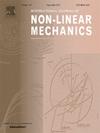斜水平磁场对对流轧辊的影响
IF 2.8
3区 工程技术
Q2 MECHANICS
International Journal of Non-Linear Mechanics
Pub Date : 2025-04-19
DOI:10.1016/j.ijnonlinmec.2025.105111
引用次数: 0
摘要
我们通过执行三维直接数值模拟,研究了在瑞利-巴姆纳德对流范式下,在导电低普朗特数流体中,斜施加于对流卷上的外部水平磁场(与x轴成φ角)的影响。当普朗特数Pr=0.1和0.2时,考虑水平纵横比(Γ)为12、1和2,控制参数钱德拉塞卡数(Q)和简化瑞利数r(瑞利数与临界瑞利数之比)在0≤Q≤1000和1≤r≤20范围内变化。在没有磁场的情况下,对流以稳定滚动的形式开始,包括平行于x轴的滚动。当斜水平磁场以与x轴成一定角度的ϕ∈(0°,90°)打开时,可以观察到磁场横于对流辊子轴线的分量所产生的洛伦兹力会抑制对流。因此,随着磁场的作用,对流被抑制,并以稳定对流辊的形式重新开始,以获得更高的瑞利数。根据参数的选择,轧辊可以与x轴以0°(稳定平行轧辊,SPR)或45°(稳定斜轧辊,SOR+)或135°(稳定斜轧辊,SOR -)的角度定向。在高r值条件下,研究了由静止流型和运动流型组成的丰富分岔结构。我们发现稳态轧辊的振荡不稳定性以两个不同指数的Qα来标度,一个指数表示较弱的磁场,一个指数表示较强的磁场。研究表明,对于一组给定的Q和Pr值,传热被抑制与φ的增加。本文章由计算机程序翻译,如有差异,请以英文原文为准。
Effect of oblique horizontal magnetic field on convection rolls
We investigate the effect of external horizontal magnetic field applied on the convection rolls obliquely (at an angle with the -axis) in electrically conducting low Prandtl number fluids under the paradigm of the Rayleigh–Bénard convection by performing three-dimensional direct numerical simulations. The control parameters, namely, the Chandrasekhar number () and the reduced Rayleigh number (ratio of Rayleigh number to critical Rayleigh number), are varied in the ranges and for the Prandtl numbers and 0.2 by considering three horizontal aspect ratios (): , 1 and 2. In the absence of the magnetic field, the convection starts in the form of steady rolls including the one parallel to the -axis. As the oblique horizontal magnetic field is switched on at an angle with the -axis, it is observed that the Lorentz force generated by the component of the magnetic field transverse to the axis of the convection rolls inhibits convection. Thus, with the application of the magnetic field, the convection is suppressed and restarts for a higher Rayleigh number in the form of steady convection rolls. The rolls can be oriented at angles 0° (steady parallel rolls, SPR) or 45° (steady oblique rolls, SOR) or 135° (steady oblique rolls, SOR) with the -axis depending on the choices of the parameters. A rich bifurcation structure consisting of standing and traveling flow patterns associated with these steady flow patterns for higher values is investigated in detail. The oscillatory instability of the steady rolls is found to scale as with two distinct exponents, one each for weaker and stronger magnetic fields. The investigation reveals that for a given set of values of and , the heat transfer is inhibited with the increase of .
求助全文
通过发布文献求助,成功后即可免费获取论文全文。
去求助
来源期刊
CiteScore
5.50
自引率
9.40%
发文量
192
审稿时长
67 days
期刊介绍:
The International Journal of Non-Linear Mechanics provides a specific medium for dissemination of high-quality research results in the various areas of theoretical, applied, and experimental mechanics of solids, fluids, structures, and systems where the phenomena are inherently non-linear.
The journal brings together original results in non-linear problems in elasticity, plasticity, dynamics, vibrations, wave-propagation, rheology, fluid-structure interaction systems, stability, biomechanics, micro- and nano-structures, materials, metamaterials, and in other diverse areas.
Papers may be analytical, computational or experimental in nature. Treatments of non-linear differential equations wherein solutions and properties of solutions are emphasized but physical aspects are not adequately relevant, will not be considered for possible publication. Both deterministic and stochastic approaches are fostered. Contributions pertaining to both established and emerging fields are encouraged.

 求助内容:
求助内容: 应助结果提醒方式:
应助结果提醒方式:


